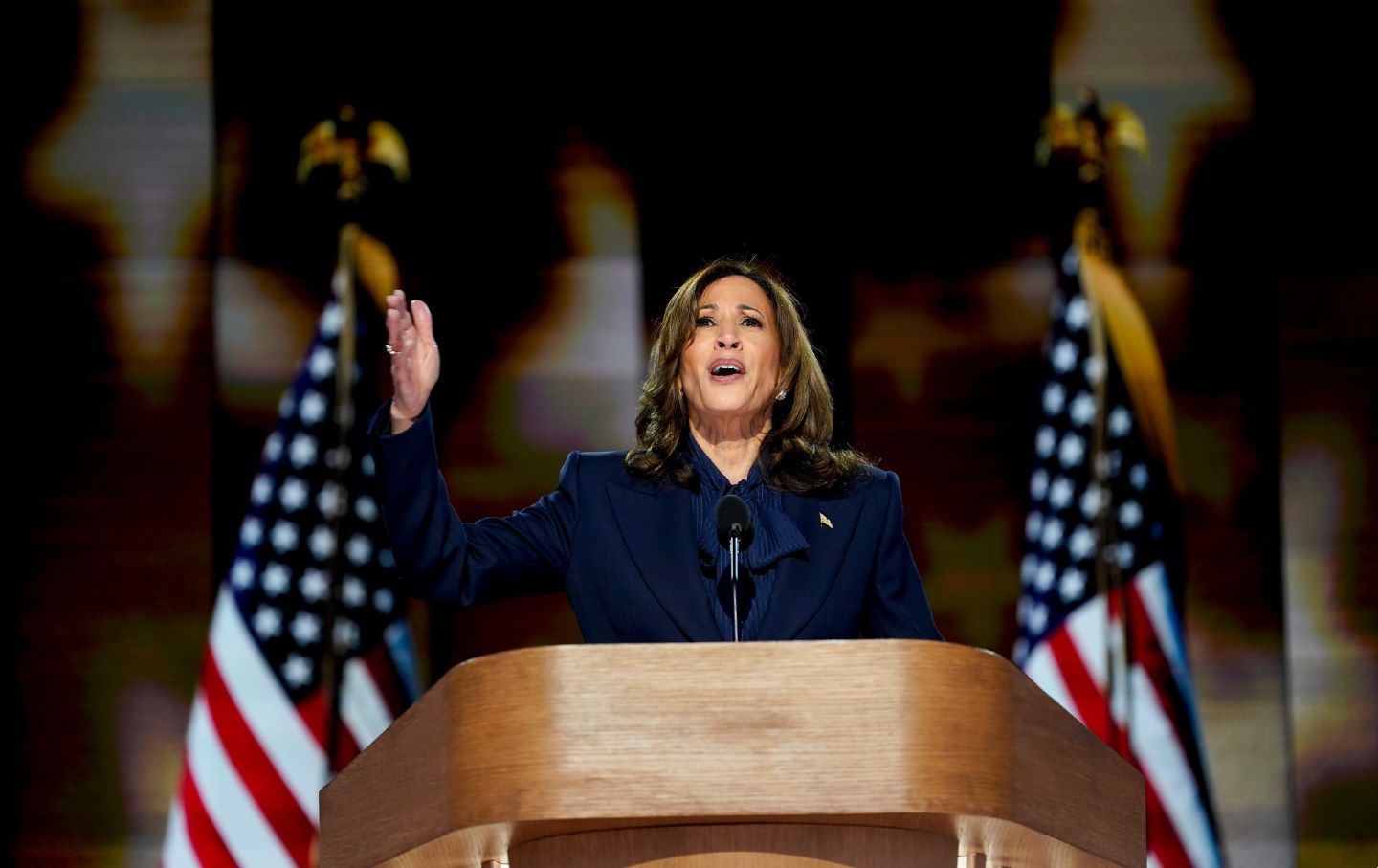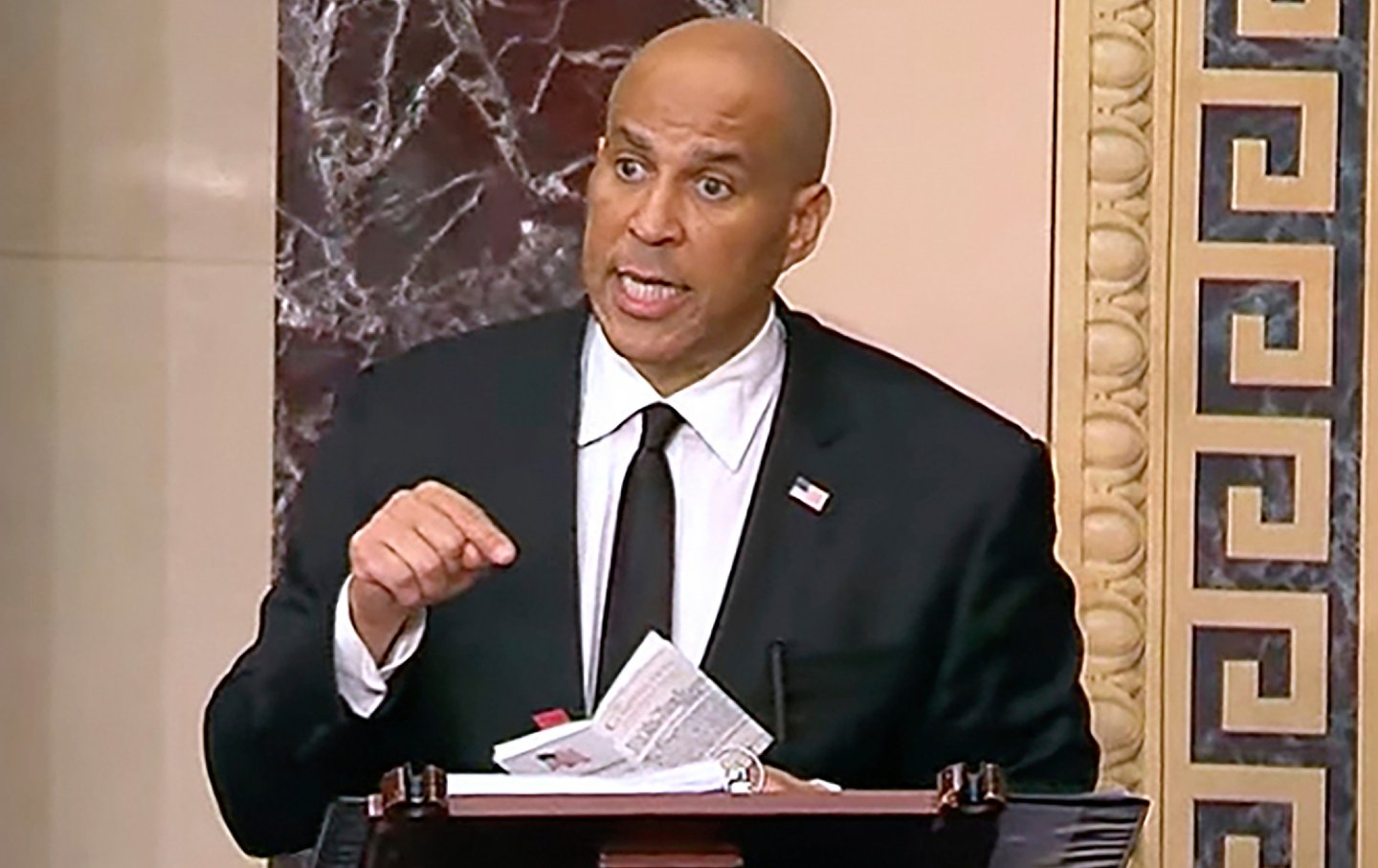After Chicago: The Challenge Facing Harris
Will she demonstrate clearly why she’s the true champion of working people?

Kamala Harris speaks during the Democratic National Convention in Chicago on August 22, 2024.
(Al Drago / Bloomberg via Getty Images)
For Democrats, the Chicago convention proved a contact high. Unified behind Kamala Harris, the party proudly displayed its glitz and glamor and unfurled its big tent, including union workers, billionaires, and Republicans with a clue. Harris starts a two-month sprint up a very big hill with the wind at her back. She will no doubt enjoy a bump in the polls from a convention that so flummoxed Donald Trump that he incredibly promised to be “great” on women’s reproductive rights while signaling that he may pull out of the September 10 debate. For Harris, the next challenge is to define her vision and agenda for the country—what she wants to accomplish and whom she is prepared to take on to get it done.
The convention effectively set the stage. Trump, whose menace unifies Democrats, was the central target, from Obama’s size joke to Clinton’s shot at his age, to Walz’s “weird and dangerous.” The jibes were punctuated by the chant “We’re not going back”—framing Trump as the failed past and Harris as the agent of change, the advocate of the “new way forward.” At a time when 60 percent of the country thinks we’re on the wrong track, this is no mean feat.
Harris chose to emphasize her experience not as senator or vice president but as a prosecutor: “Kamala Harris for the people.” This creates a striking contrast between the prosecutor and the felon. More important, it enables her to highlight whom she is prepared to fight against: sexual predators, big banks that defraud homeowners, corporations that gouge consumers, businesses that cheat their workers, for-profit colleges that scam veterans, foreign cartels that traffic in drugs, guns, and humans. It lends structure to her claim to be for the middle class.
Now, Harris must put some meat on these bones. Her economic strategy and agenda must be the core of this. This inevitably occasions fierce jockeying between the Democratic donor class and progressives. Predictably, the purveyors of conventional wisdom have already urged her to move to the center, whatever that means. One of the largest donors to the Democratic Party, Reid Hoffman of LinkedIn, publicly called on Harris to fire Lina Khan, the head of the Federal Trade Commission, essentially to gut Biden’s surprisingly bold antitrust policy. The cryptocurrency grifters have amassed a $100 million war chest. When the Harris campaign reached out to “reset” relations, they urged firing SEC Chair Gary Gensler, essentially a demand that they be left free to continue the speculation, money-laundering, and tax evasion that are the primary uses of their ersatz “currencies.”
The progressive wing of the party is on a back foot in this jockeying. In 2020, progressive movements like Black Lives Matter and #MeToo roused activists. The Sanders insurgency in the primaries created excitement around a bold agenda. Needing that energy, Biden organized his “unity task forces,” which transformed his priorities. When he was elected, Democrats controlled the House and an emboldened Congressional Progressive Caucus, acting collectively for the first time under its chair Pramila Jayapal, helped expand and drive through dramatic reforms, only some of which survived the divided Senate.
In this cycle, a revived labor movement and the reaction to the assault on abortion rights provide energy, but without primaries, there’s no Sanders surge. Biden’s failure to end the horror in Gaza divides and enrages. Armed with millions from Republican billionaires, AIPAC and its fronts spent $25 million to take out two sitting progressive legislators in Democratic primaries, and millions more to defeat promising newcomers like Pramila Jayapal’s sister, Susheela Jayapal. All this was met with silence from Democratic Party leadership.
Harris herself has quietly discarded her 2020 campaign’s support for Medicare for All and a ban on fracking. The party’s position on immigration is now centered on the bipartisan reform bill—written with the most conservative Senate Republican—that Trump torpedoed to keep the issue alive. While sensible gun control remains on the agenda, police reform has dropped off. As Richard Eskow has detailed, the 2024 party platform—essentially the party establishment’s view of the party’s common denominator—dropped several progressive reforms that had been in the 2020 version.
That said, what’s more important is what remains in the platform, rather than what has been trimmed. It calls for minimum taxes on billionaires and corporations, taxing income from wealth at the same rates as income from work, reviving the expanded child tax credit that reduced childhood poverty by 40 percent, providing affordable day care and college, taking on Big Pharma and reducing drug prices, going after price gouging and corporate monopolies, lifting the minimum wage and empowering workers to organize, while giving them paid family leave. It lays out the next stage in Biden’s industrial and trade policy, generating good jobs in rebuilding the country, while accelerating the transition to renewable energy.
While progressives are underrepresented in the party’s leadership and apparatchiks, “this is a progressive party,” Representative Jamie Raskin argued in an interview at the convention. “It just is. The energy comes from progressives; the ideas come from progressives; the most exciting leaders are progressive; the young are progressive. Even most of the money is progressive. And it is now grounded in an agenda focused on putting the struggles of working people at the front of our work.”
A glaring exception to this is foreign policy. Here the “Blob”—the foreign policy establishment that has led us into one catastrophe after another—retains control. In her convention address, Harris embraced the belief that America is the indispensable nation, committed from Ukraine to Gaza to the South China Sea. The 2024 platform even attacks Trump for being too timid in taking on Iran. The bellicosity enables Trump to posture as the peace candidate in a nation tired of constant wars. And it exposes Harris to the perils of the horror in Gaza continuing, the Middle East blowing up, or Ukraine collapsing. If the Democratic Party truly is to become progressive, then Biden’s rhetoric about a “foreign policy for the middle class” must be turned from words into reality.
This handicap only reinforces the need for Harris to demonstrate clearly why she is the true champion of working people. Trump’s rise is a perverted expression of widespread despair, cynicism, and anger at a failed establishment. He postures, however improbably, as the champion of the disaffected and the abused, even while employing racist tropes to distract and divide. While his actual policies feature standard conservative Republican fare of top-end tax cuts and deregulation, he spices that with the assault on immigrants and decrying failed trade policies and the endless wars that he paints as products of an incompetent and un-American liberal establishment.
In the first frenetic weeks of her sudden campaign, Harris hasn’t had to lay out much about her “new way forward.” In her one policy speech, she focused on basic bread-and-butter concerns: a plan to reduce the price of housing and make more homes available, lower food prices by going after corporations guilty of price gouging and drug prices by taking on Big Pharma, offer financial help to families with a new child, establish an expanded Child Tax Credit, and give aid to first-time homebuyers. She’s stood with workers on picket lines, and embraced labor law reform. Her selection of Minnesota Governor Tim Walz adds credibility to the care agenda since he passed many of these measures—plus free student lunches—in his state.
She has little choice but to fill out this populist stance in contrast with Trump’s corruptions and contradictions. Compare his tax giveaways to the rich with a Child Tax Credit, minimum taxes on billionaires and corporations. Contrast his corrupt bargain with Big Oil with the jobs and cost savings generated by expanding renewable energy rapidly and beginning to address the climate threat. Indict his party’s efforts to cut Medicare with Democrats’ aim to expand it to include dental, vision, and hearing. Contrast his tired invocation of top-end tax cuts to drive the economy with the next stage of a robust industrial policy rebuilding the country and capturing the technologies of the future.
Popular
“swipe left below to view more authors”Swipe →In little more than two months, Harris will need to provide voters with a clear argument of how she will address their concerns and make the economy work. She’ll have to do this in the midst of a no-holds-barred campaign, barraged by Trump’s insults and lies designed to tag her as the other, the alien, the incompetent. She’ll need to retain her image as a joyous warrior for the people. In a country of partisan division and racial reaction, this won’t be easy. She’ll need activists across the country mobilized to help drive her up the hill. There’s no time to waste.








